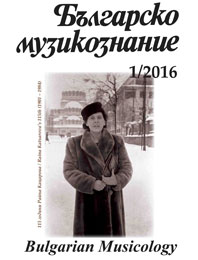Ганка Неделчева: Две издания посветени на ноктюрните за пиано от Димитър Христов
Ganka Nedelcheva: Two editions devoted to Dimiter Christoff’s nocturnes for piano Dimiter Christoff’s nocturnes for piano in Bulgarian and international experience. Interpretational polysemy of the technological parallel with Chopin’s nocturnes
Author(s): Elisaveta Valchinova-ChendovaSubject(s): History, Theatre, Dance, Performing Arts, Fine Arts / Performing Arts, Cultural history, Music, Essay|Book Review |Scientific Life, Review, General Reference Works, Book-Review
Published by: Институт за изследване на изкуствата, Българска академия на науките
Summary/Abstract: Prof. Ganka Nedelcheva’s studies of the cycle of 12 nocturnes by Dimiter Christoff are related to her activities of a pianist. Over the last decade and a half Prof. Ganka Nedelcheva has been the premiere performer of a number of Dimiter Christoff’s pieces. The author has had a unique chance to theoretically figure out her interpretational and pedagogical experience. Her first book, Dimiter Christoff’s nocturnes for piano in Bulgarian and international experience. Interpretational polysemy of the technological parallel with Chopin’s nocturnes is a theoretical study. Nocturne is treated as an idea, a title existing over time to tempt composers. For the purposes of her study, the author spells out the term nocturne, specifying it terminologically. Her rationale for treating it as a title, relates more often than not to a broader creative interpretation of the known characteristics of the genre of short piano pieces. The approaches to nocturne are traced in the context of the nineteenth- and the twentieth century Bulgarian music and musical experience. Her text has also an informative value with the large amount of examples, placed historically and stylistically. The two time span benchmarks in the study, Fryderyk Chopin and Dimiter Christoff, are treated through technological aspects of expression. Night with Chopin and Christoff is not just a parallel: through the title nocturne Chopin’s arguments of romanticism suggest parallels with the contemporary compositional project of Dimiter Christoff at the turn of the twenty-first century. The author asks as to whether the turn of the twenty-first century has not given rise to a new romanticism, to a new avant- garde that is mostly aesthetical, being achieved musically and technologically through new idioms. The emergence of Dimiter Christoff’s 12 nocturnes for piano is significant both to Bulgarian and world music with its cyclical form. The 12 faces of night in Dimiter Christoff’s nocturnes for piano. A possible performative vision contains facsimiles of the author’s scores with a thorough semantic and concrete pianistic interpretational analysis of each of them (p. 52). This idea is brilliantly vindicated, which makes it especially valuable to potential performers and researchers.
Journal: Българско музикознание
- Issue Year: 2016
- Issue No: 1
- Page Range: 112-117
- Page Count: 6
- Language: Bulgarian
- Content File-PDF

